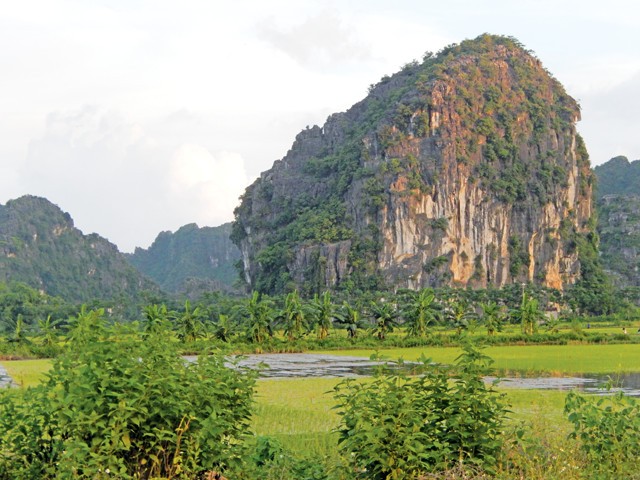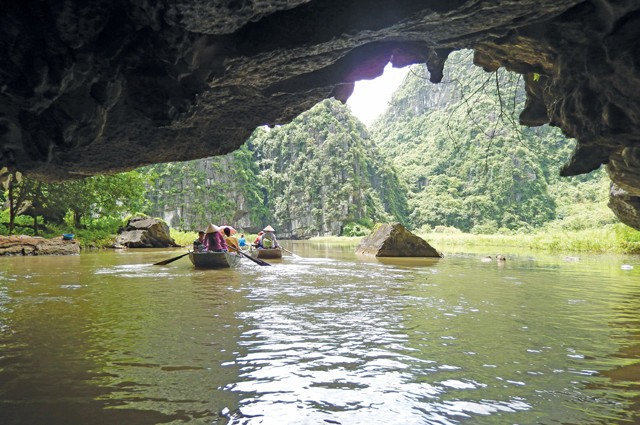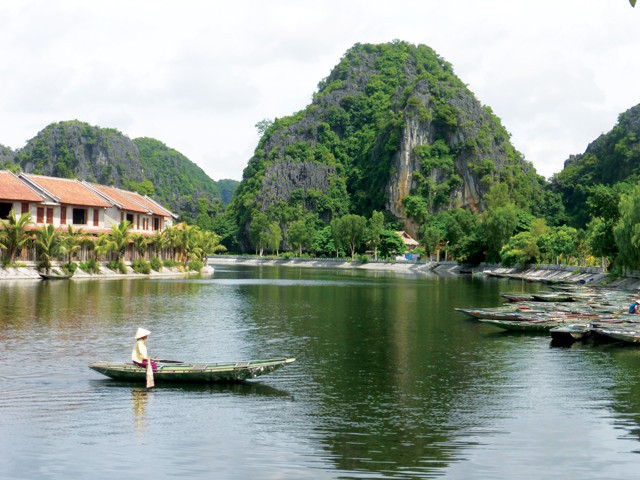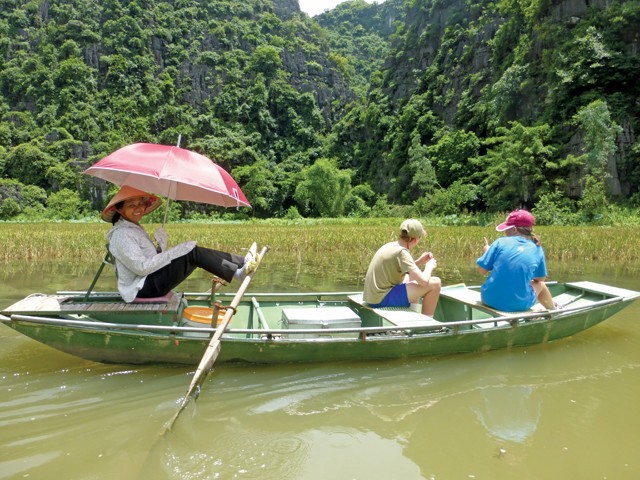Are you curious about the stunning landscapes of Ninh Binh, Vietnam? This region is renowned for its unique geological formations, particularly karst limestone. Let SIXT.VN guide you through the wonders of Ninh Binh, where dramatic scenery meets rich history. Discover the geological marvels of karst limestone formations and how they shape the breathtaking landscapes of this Vietnamese gem.
1. What is Karst Limestone and How Does it Form in Ninh Binh?
Karst limestone is a distinctive geological formation that dominates the landscape of Ninh Binh. It forms through the dissolution of soluble rocks such as limestone, dolomite, and gypsum. This process is significantly influenced by the region’s climate, characterized by high rainfall and humidity. According to a study by the Vietnam National University, Hanoi, the karst topography in Ninh Binh began forming millions of years ago, creating a unique environment rich in biodiversity and geological significance.
The formation of karst limestone involves several key stages:
- Dissolution: Rainwater, slightly acidic due to absorbed carbon dioxide from the atmosphere and soil, seeps into cracks and fissures in the limestone.
- Erosion: The acidic water gradually dissolves the limestone, widening the cracks and creating underground drainage systems.
- Cave Formation: Over time, the dissolution process leads to the development of extensive cave systems.
- Collapse: The roofs of some caves collapse, forming sinkholes and creating the characteristic tower karst topography seen in Ninh Binh.
 Karst limestone formations in Ninh Binh, showcasing their unique tower-like structures
Karst limestone formations in Ninh Binh, showcasing their unique tower-like structures
2. What Are the Key Features of Karst Limestone Landscapes in Ninh Binh?
Ninh Binh’s karst limestone landscapes are characterized by several distinctive features:
- Tower Karst: Tower karst landscapes consist of steep, isolated limestone towers rising dramatically from the surrounding plains. These towers are remnants of the original limestone plateau, sculpted by millions of years of erosion.
- Caves and Grottos: The region is riddled with numerous caves and grottos, many of which are accessible by boat. These caves often feature stunning stalactites and stalagmites, formed by the deposition of calcium carbonate from dripping water.
- Underground Rivers: The dissolution process creates extensive underground drainage systems, including subterranean rivers that flow through the karst landscape.
- Sinkholes: Sinkholes, or dolines, are depressions formed by the collapse of cave roofs or the dissolution of surface limestone. They are a common feature in karst landscapes and contribute to the irregular topography of Ninh Binh.
Exploring these landscapes offers a unique opportunity to witness the power of natural processes and the beauty they create. Consider a guided tour with SIXT.VN to fully appreciate these geological wonders.
3. Where Can You See the Best Examples of Karst Limestone in Ninh Binh?
Ninh Binh boasts several locations where you can witness the stunning karst limestone formations:
- Tam Coc (Three Caves): Often referred to as “Ha Long Bay on land,” Tam Coc features a series of three caves accessible by a scenic boat ride along the Ngo Dong River. The karst towers rise majestically from the rice paddies, creating a picturesque landscape.
- Trang An Landscape Complex: A UNESCO World Heritage site, Trang An offers a similar landscape to Tam Coc but with a more extensive network of caves and waterways. Boat tours through Trang An provide an immersive experience of the karst formations.
- Mua Cave (Hang Mua): Climbing to the top of Mua Cave offers panoramic views of the surrounding karst landscape, including the Ngo Dong River and Tam Coc. The viewpoint is particularly stunning at sunrise and sunset.
 Scenic boat tour in Tam Coc, showcasing the karst towers along the Ngo Dong River
Scenic boat tour in Tam Coc, showcasing the karst towers along the Ngo Dong River
4. How Does the Climate Influence Karst Formation in Ninh Binh?
The tropical monsoon climate of Ninh Binh plays a crucial role in the formation of its karst landscapes. The high rainfall and humidity accelerate the dissolution process, leading to rapid erosion of the limestone. The seasonal variations in rainfall also contribute to the dynamic nature of the karst environment, with alternating periods of intense erosion and deposition.
According to the Vietnam Institute of Geosciences and Mineral Resources, the average annual rainfall in Ninh Binh ranges from 1,800 to 2,000 mm, providing ample water for the dissolution of limestone. The warm temperatures further enhance the chemical reactions involved in the process.
5. What is the Significance of Karst Limestone for Biodiversity in Ninh Binh?
Karst limestone landscapes support a diverse range of plant and animal species, many of which are endemic to the region. The unique geological formations create a variety of habitats, including caves, cliffs, and forests, each supporting its own distinct ecological community.
Key aspects of biodiversity in Ninh Binh’s karst region include:
- Endemic Species: The isolated nature of karst towers promotes the evolution of endemic species, plants and animals found nowhere else in the world.
- Cave Ecosystems: Caves provide habitat for specialized cave-dwelling species, such as bats, insects, and crustaceans, adapted to the dark, humid environment.
- Forests: The slopes of karst towers are often covered in lush forests, providing habitat for a variety of birds, mammals, and reptiles.
 Lush greenery covering the karst formations in Ninh Binh, highlighting the region's biodiversity
Lush greenery covering the karst formations in Ninh Binh, highlighting the region's biodiversity
6. What Role Does Tectonics Play in Shaping Ninh Binh’s Karst Landscapes?
Tectonic activity has played a significant role in shaping the karst landscapes of Ninh Binh. The region lies near the Red River Fault, a major tectonic feature that has influenced the geological structure of Northern Vietnam. Movements along this fault have uplifted and fractured the limestone formations, making them more susceptible to erosion.
Additionally, the Indosinian Orogeny, a period of mountain-building that occurred millions of years ago, contributed to the folding and faulting of the limestone layers. This tectonic activity created the complex geological structure that underlies Ninh Binh’s karst landscapes.
7. How Do Local Communities Interact With the Karst Limestone Environment in Ninh Binh?
Local communities in Ninh Binh have a long history of interacting with the karst limestone environment. They have adapted their livelihoods to the unique conditions of the region, utilizing the natural resources in a sustainable manner.
Examples of local interactions with the karst environment include:
- Agriculture: Rice cultivation in the valleys between karst towers is a traditional practice, utilizing the fertile soils deposited by the Red River.
- Fishing: Local fishermen use the rivers and streams that flow through the karst landscape to catch fish and other aquatic resources.
- Tourism: The growing tourism industry provides employment opportunities for local communities, who work as boat drivers, guides, and guesthouse operators.
It is important to promote sustainable tourism practices that protect the karst environment and benefit local communities. SIXT.VN is committed to responsible tourism, ensuring that our tours contribute to the preservation of Ninh Binh’s natural and cultural heritage.
8. What Are Some Myths and Legends Associated With Ninh Binh’s Karst Limestone Formations?
The dramatic landscapes of Ninh Binh have inspired numerous myths and legends among the local population. These stories often attribute the formation of the karst towers to supernatural forces or mythical creatures.
One popular legend tells of a dragon who descended from the heavens to protect the Vietnamese people from invaders. The dragon spat out pearls that turned into the limestone towers, creating a natural barrier that repelled the enemy. This legend is similar to the one associated with Ha Long Bay, highlighting the cultural significance of karst landscapes in Vietnamese folklore.
9. What Conservation Efforts Are in Place to Protect Ninh Binh’s Karst Limestone?
Recognizing the unique geological and ecological value of Ninh Binh’s karst landscapes, several conservation efforts are in place to protect them. These efforts are aimed at preserving the natural environment, promoting sustainable tourism, and supporting local communities.
Key conservation initiatives include:
- UNESCO World Heritage Status: The Trang An Landscape Complex was designated a UNESCO World Heritage site in 2014, recognizing its outstanding universal value.
- National Parks and Reserves: Parts of Ninh Binh are protected as national parks and nature reserves, safeguarding biodiversity and natural habitats.
- Sustainable Tourism Programs: Various programs promote sustainable tourism practices, encouraging responsible behavior among tourists and supporting local communities.
 Conservation efforts aimed at preserving the natural beauty of Ninh Binh's karst landscape
Conservation efforts aimed at preserving the natural beauty of Ninh Binh's karst landscape
10. How Can SIXT.VN Enhance Your Experience Exploring Ninh Binh’s Karst Limestone?
SIXT.VN offers a range of services to enhance your experience exploring Ninh Binh’s karst limestone landscapes:
- Tailored Itineraries: We can create customized itineraries that cater to your interests and preferences, ensuring you see the best of Ninh Binh’s geological wonders.
- Expert Guides: Our knowledgeable guides will provide insights into the formation, ecology, and cultural significance of the karst landscapes.
- Comfortable Transportation: We offer comfortable and reliable transportation options, including private cars and shuttle services, to ensure a smooth and hassle-free journey.
- Accommodation: We can arrange accommodation in a range of hotels and guesthouses, from budget-friendly options to luxurious resorts.
- Boat Tours: Experience the beauty of Tam Coc and Trang An with our expertly organized boat tours, allowing you to glide through the karst landscape in comfort and style.
Ready to Explore Ninh Binh?
Don’t miss the opportunity to witness the geological wonders of Ninh Binh’s karst limestone formations. Contact SIXT.VN today to book your tour and discover the beauty and magic of this Vietnamese gem.
11. What Are the Best Times to Visit Ninh Binh to See the Karst Limestone?
The best times to visit Ninh Binh for optimal weather and scenic beauty are during the dry seasons:
- Spring (March to May): The weather is pleasant with moderate temperatures and lower humidity. This is an ideal time to see the rice paddies in their vibrant green phase.
- Autumn (September to November): Similar to spring, autumn offers comfortable temperatures and less rainfall, making it perfect for outdoor activities and exploring the karst landscapes.
Avoid the summer months (June to August) due to high temperatures and heavy rainfall, which can make travel less enjoyable.
12. What Should You Wear and Bring When Visiting Ninh Binh’s Karst Limestone Areas?
When visiting Ninh Binh’s karst limestone areas, it’s essential to be prepared for outdoor activities and varying weather conditions. Here’s a list of recommended items:
- Comfortable Clothing: Lightweight, breathable fabrics are ideal. Opt for clothing that allows ease of movement, especially if you plan to hike or climb.
- Sturdy Footwear: Hiking shoes or sturdy walking shoes are recommended, especially for exploring caves and climbing to viewpoints like Mua Cave.
- Rain Gear: Even during the dry season, occasional showers can occur. Pack a lightweight raincoat or umbrella.
- Sun Protection: Sunscreen, a hat, and sunglasses are crucial for protecting yourself from the sun’s rays.
- Insect Repellent: Mosquitoes and other insects can be prevalent, especially in the evenings.
- Water Bottle: Stay hydrated by bringing a reusable water bottle.
- Camera: Capture the stunning landscapes and memorable moments.
- Cash: While some establishments accept credit cards, it’s wise to carry cash for smaller vendors and entrance fees.
13. What Types of Accommodation Are Available Near Ninh Binh’s Karst Limestone Formations?
Ninh Binh offers a range of accommodation options to suit different budgets and preferences, from budget-friendly hostels to luxurious resorts:
- Hotels: Numerous hotels are available in Ninh Binh city and near the popular tourist areas like Tam Coc and Trang An.
- Homestays: For a more immersive experience, consider staying in a local homestay. This option provides a chance to interact with local families and learn about their culture.
- Resorts: Several resorts offer luxurious amenities and stunning views of the karst landscapes.
- Guesthouses: Guesthouses are a budget-friendly option that offers basic but comfortable accommodations.
SIXT.VN can assist you in finding and booking the perfect accommodation to match your needs and preferences.
14. What Local Cuisine Should You Try When Visiting Ninh Binh?
Ninh Binh is known for its unique and delicious cuisine, with several local specialties that you should try:
- Com Chay (Burnt Rice): A crispy rice dish served with various toppings, such as meat, seafood, and vegetables.
- De Tai Chanh (Lemon Goat): A flavorful goat dish marinated in lemon juice and spices.
- Goi Ca Nhech (Raw Fish Salad): A refreshing salad made with raw fish, herbs, and spices.
- Banh Da Ca (Fish Noodle Soup): A hearty noodle soup with fish, vegetables, and herbs.
- Oc Nui (Mountain Snails): Snails harvested from the limestone mountains, cooked in various ways.
15. Are There Any Eco-Friendly Tourism Practices in Ninh Binh’s Karst Limestone Areas?
Yes, several eco-friendly tourism practices are being implemented in Ninh Binh’s karst limestone areas to minimize the environmental impact and promote sustainability:
- Boat Tours with Electric Motors: Some boat tours use boats with electric motors to reduce noise pollution and minimize disturbance to the natural environment.
- Waste Management Programs: Local authorities and tourism operators are implementing waste management programs to reduce litter and promote recycling.
- Community-Based Tourism: Supporting local homestays and businesses helps to distribute the economic benefits of tourism more widely and encourages sustainable practices.
- Educational Initiatives: Providing information to tourists about responsible behavior and the importance of preserving the environment.
By choosing eco-friendly tour operators and accommodations, you can contribute to the preservation of Ninh Binh’s karst limestone landscapes. SIXT.VN is committed to promoting responsible tourism and working with local partners to ensure the sustainability of the region.
16. How Can You Get to Ninh Binh From Hanoi?
Getting to Ninh Binh from Hanoi is relatively easy, with several transportation options available:
- Train: The train is a comfortable and scenic option, with daily departures from Hanoi to Ninh Binh. The journey takes approximately 2.5 to 3 hours.
- Bus: Numerous buses operate between Hanoi and Ninh Binh, departing from various bus stations in Hanoi. The journey takes approximately 2 to 3 hours, depending on traffic.
- Private Car: Hiring a private car is a convenient and flexible option, allowing you to travel at your own pace and stop at attractions along the way. The journey takes approximately 1.5 to 2 hours.
- Shuttle Bus: Some tour operators offer shuttle bus services between Hanoi and Ninh Binh, providing a convenient and hassle-free transfer.
SIXT.VN offers reliable and comfortable transportation services from Hanoi to Ninh Binh, ensuring a smooth and enjoyable journey.
17. What Other Activities Can You Do Besides Exploring Karst Limestone in Ninh Binh?
In addition to exploring the karst limestone formations, Ninh Binh offers a variety of other activities and attractions:
- Visit Hoa Lu Ancient Capital: Explore the ancient temples and historical sites of Hoa Lu, the former capital of Vietnam during the 10th and 11th centuries.
- Explore Bai Dinh Pagoda: Visit the Bai Dinh Pagoda, one of the largest Buddhist complexes in Southeast Asia, featuring impressive temples, statues, and gardens.
- Bike Ride Through the Countryside: Rent a bicycle and explore the scenic countryside, passing through rice paddies, villages, and karst landscapes.
- Visit Van Long Nature Reserve: Explore the Van Long Nature Reserve, a wetland area home to diverse bird species and the endangered Delacour’s langur.
- Attend Local Festivals: Experience the local culture by attending traditional festivals and events.
18. What Is the Best Way to Experience the Caves in Ninh Binh’s Karst Limestone?
The best way to experience the caves in Ninh Binh’s karst limestone is by taking a boat tour. These tours typically involve paddling through the caves on small boats, allowing you to admire the stunning stalactites, stalagmites, and unique rock formations.
Key tips for experiencing the caves include:
- Choose a reputable tour operator: Ensure the tour operator is licensed and follows safety guidelines.
- Wear comfortable clothing: Dress in lightweight clothing and comfortable shoes, as you will be sitting in a boat for an extended period.
- Bring a camera: Capture the beauty of the caves, but be mindful of the lighting conditions.
- Listen to your guide: Pay attention to the guide’s instructions and information about the caves.
- Respect the environment: Avoid touching the rock formations and dispose of your waste properly.
19. How Does the Karst Limestone in Ninh Binh Compare to Other Karst Regions in the World?
The karst limestone landscapes in Ninh Binh share similarities with other karst regions around the world but also have unique characteristics:
- Similarities: Like other karst regions, Ninh Binh features tower karst formations, caves, sinkholes, and underground drainage systems. The dissolution of limestone is the primary process shaping the landscape.
- Differences: Ninh Binh’s karst landscapes are distinguished by their lush vegetation, rice paddies, and the integration of local communities into the environment. The region’s tropical monsoon climate also contributes to the rapid erosion and distinctive features of the karst formations.
Some other notable karst regions include:
- Ha Long Bay, Vietnam: Similar to Ninh Binh but with karst formations in a marine environment.
- Guilin, China: Known for its picturesque karst landscapes along the Li River.
- Puerto Rico: Features extensive cave systems and sinkholes.
- Balkans: Home to numerous karst landscapes with unique geological features.
20. What Travel Tips Should You Keep in Mind When Visiting Ninh Binh?
Here are some essential travel tips to enhance your visit to Ninh Binh:
- Plan Ahead: Book your accommodation, transportation, and tours in advance, especially during peak season.
- Learn Basic Vietnamese Phrases: Knowing a few basic phrases will enhance your interactions with locals.
- Bargain Respectfully: Bargaining is common in markets and with vendors, but do so respectfully.
- Be Aware of Scams: Be cautious of common tourist scams and avoid unofficial tour operators.
- Respect Local Customs: Dress modestly when visiting temples and pagodas, and be mindful of local customs and traditions.
- Stay Hydrated: Drink plenty of water to stay hydrated, especially during hot weather.
- Protect Yourself from Mosquitoes: Use insect repellent to protect yourself from mosquito bites.
- Pack Light: Pack only essential items to make your travel easier.
- Be Open to New Experiences: Embrace the local culture and be open to trying new foods and activities.
- Travel Insurance: Consider purchasing travel insurance to protect yourself from unexpected events.
FAQ about Karst Limestone in Ninh Binh
1. What exactly is karst limestone?
Karst limestone is a type of landscape formed from the dissolution of soluble rocks such as limestone, characterized by features like caves, sinkholes, and underground drainage systems.
2. How did the karst limestone formations in Ninh Binh develop?
The formations developed over millions of years through the dissolution of limestone by acidic rainwater, influenced by the region’s tropical climate and tectonic activity.
3. Where are the best places to see karst limestone in Ninh Binh?
Top spots include Tam Coc, Trang An Landscape Complex, and Mua Cave, each offering unique perspectives and experiences of the karst formations.
4. What role does climate play in shaping Ninh Binh’s karst limestone?
The tropical monsoon climate, with its high rainfall and humidity, accelerates the dissolution process, leading to the rapid erosion and formation of the karst landscape.
5. What kind of biodiversity is supported by karst limestone in Ninh Binh?
Karst limestone supports a diverse range of plant and animal species, including endemic species adapted to the unique habitats created by the karst formations.
6. Are there any myths associated with Ninh Binh’s karst limestone formations?
Yes, local legends often attribute the formation of the karst towers to mythical creatures, such as dragons who created them to protect the Vietnamese people.
7. What conservation efforts are in place to protect Ninh Binh’s karst limestone?
Conservation efforts include UNESCO World Heritage status for Trang An, national parks and reserves, and sustainable tourism programs.
8. Can I explore the caves in Ninh Binh’s karst limestone?
Yes, boat tours are a popular way to explore the caves, allowing you to admire the stunning stalactites and stalagmites.
9. What are some other attractions besides karst limestone in Ninh Binh?
Other attractions include Hoa Lu Ancient Capital, Bai Dinh Pagoda, Van Long Nature Reserve, and the opportunity to bike through the picturesque countryside.
10. How can SIXT.VN help me explore Ninh Binh’s karst limestone?
SIXT.VN offers tailored itineraries, expert guides, comfortable transportation, and accommodation options to enhance your experience exploring Ninh Binh’s karst limestone.
Ready to discover the geological wonders of Ninh Binh? Let SIXT.VN be your guide to an unforgettable adventure. Contact us today to book your tour and experience the beauty of Vietnam’s karst limestone landscapes.
Address: 260 Cau Giay, Hanoi, Vietnam
Hotline/Whatsapp: +84 986 244 358
Website: SIXT.VN



